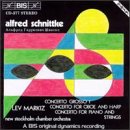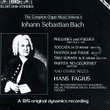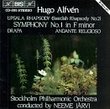| All Artists: Alfred Schnittke, Lev Markiz, New Stockholm Chamber Orchestra, Roland Pontinen, Christian Bergqvist, Patrik Swedrup, Helen Jahren, Kjell Axel Lier Title: Alfred Schnittke: Concerto Grosso No. 1 / Concerto for Oboe & Harp / Concerto for Piano & Strings Members Wishing: 0 Total Copies: 0 Label: Bis Release Date: 7/6/1993 Album Type: Import Genre: Classical Styles: Forms & Genres, Concertos, Instruments, Keyboard, Strings Number of Discs: 1 SwapaCD Credits: 1 UPCs: 750582019722, 7318590003770 |
Search - Alfred Schnittke, Lev Markiz, New Stockholm Chamber Orchestra :: Alfred Schnittke: Concerto Grosso No. 1 / Concerto for Oboe & Harp / Concerto for Piano & Strings
CD DetailsSimilar CDs |
CD ReviewsGood performances of two concertos, with one concerto I'm un Christopher Culver | 01/15/2007 (3 out of 5 stars) "This BIS disc, an early entry in the label's admirable attempt to issue Schnittke's complete works, contains three concertos for soloist(s) and string orchestra. Lev Markiz leads the New Stockholm Chamber Orchestra.
The "Concerto grosso no. 1" for two violins, harpsichord, prepared piano, and string orchestra (1977) is performed here by the Chamber Orchestra of Europe conducted by Heinrich Schiff with Kremer and Tatyana Gridenko on violin and Yuri Smirnov on both harpischord and prepared piano. The work is a typical example of Schnittke's "polystylism", where the most modern techniques are combined with throwbacks to baroque and classical sounds in a way that, strangely, isn't incongruous. Among composers whose work Schnittke has absorbed here in parody or direct quotation are Vivaldi, Mozart, Beethoven, Webern, and Tchaikovsky. The work is even rounded out by a tango on the harpischord. A fun work. Violinists Christian Bergqvist and Patrik Swedrup and pianist Roland Pontinen give a fine performance here. I slightly prefer, however, the Soviet-era performance--also with Gridenko and Kremer--that is available both on a disc in the Moscow Studio Archives series and on a Collegno collection of Schnittke pieces. This performance lacks a certain zaniness found in the Soviet performance. The "Concerto for oboe, harp and string orchesra" (1971) was a commision from Heinz and Ursula Holliger; here the soloists are Helen Jahren on oboe and Kjell Axel Lier on harp. It was written in memory of two deceased friends, though instead of any simply constructed elegy we find series increasingy hysterical laments. While the lines of the soloists are individually intriguing, I think the work as a whole lacks cohesion. Perhaps it's just a fault of the performance--this is a concerto rarely (never?) recorded elsewhere. The "Concerto for piano and string orchestra" (1979) uses many different features and is a combination of variation, sonata, and cyclic form, with one theme related to Orthodox chant and another a twelve-tone series with tonal features. The concerto starts its peak early with an ostinato reminscent of Sofia Gubaidulina ("Zeitgestalten" or the "Viola Concerto"), and then a heavy cadenza, while the second half of the piece is played piano. This is a fine work, and one of the composer's most accessible and engaging--and least depressing. This is my favourite performance yet of the work, as Pontinen's piano performance is impeccable, and while some conductors let the latter half drag, Markiz keeps things at a tight 20:30. I think that the best introductions to Schnittke are the two disc on Moscow Studio Archives, one with the first Concerto Grosso and the cello concerto, the other with the second Concerto Grosso and the viola concerto. However, if you've started building a collection of the great Russian composer, and BIS has nicely made this easy, then you can pick up this along the way." |


 Track Listings (8) - Disc #1
Track Listings (8) - Disc #1
